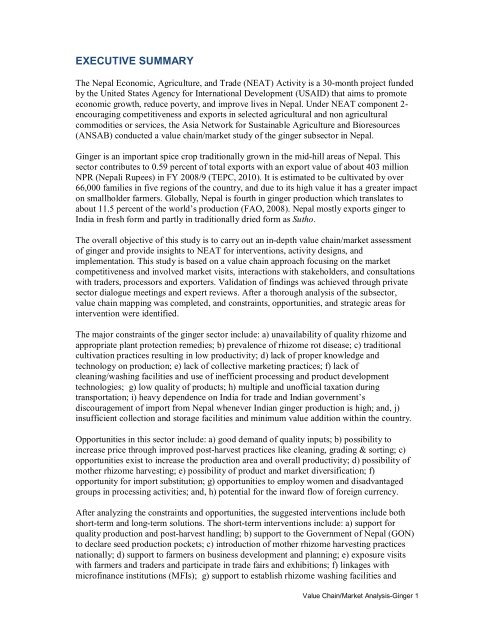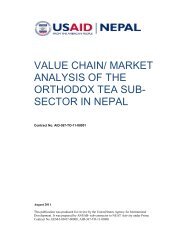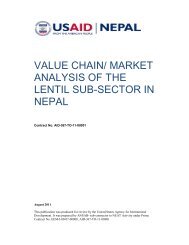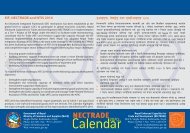value chain/ market analysis of the ginger sub-sector ... - Nepal Trade
value chain/ market analysis of the ginger sub-sector ... - Nepal Trade
value chain/ market analysis of the ginger sub-sector ... - Nepal Trade
- No tags were found...
You also want an ePaper? Increase the reach of your titles
YUMPU automatically turns print PDFs into web optimized ePapers that Google loves.
EXECUTIVE SUMMARYThe <strong>Nepal</strong> Economic, Agriculture, and <strong>Trade</strong> (NEAT) Activity is a 30-month project fundedby <strong>the</strong> United States Agency for International Development (USAID) that aims to promoteeconomic growth, reduce poverty, and improve lives in <strong>Nepal</strong>. Under NEAT component 2-encouraging competitiveness and exports in selected agricultural and non agriculturalcommodities or services, <strong>the</strong> Asia Network for Sustainable Agriculture and Bioresources(ANSAB) conducted a <strong>value</strong> <strong>chain</strong>/<strong>market</strong> study <strong>of</strong> <strong>the</strong> <strong>ginger</strong> <strong>sub</strong><strong>sector</strong> in <strong>Nepal</strong>.Ginger is an important spice crop traditionally grown in <strong>the</strong> mid-hill areas <strong>of</strong> <strong>Nepal</strong>. This<strong>sector</strong> contributes to 0.59 percent <strong>of</strong> total exports with an export <strong>value</strong> <strong>of</strong> about 403 millionNPR (<strong>Nepal</strong>i Rupees) in FY 2008/9 (TEPC, 2010). It is estimated to be cultivated by over66,000 families in five regions <strong>of</strong> <strong>the</strong> country, and due to its high <strong>value</strong> it has a greater impacton smallholder farmers. Globally, <strong>Nepal</strong> is fourth in <strong>ginger</strong> production which translates toabout 11.5 percent <strong>of</strong> <strong>the</strong> worlds production (FAO, 2008). <strong>Nepal</strong> mostly exports <strong>ginger</strong> toIndia in fresh form and partly in traditionally dried form as Sutho.The overall objective <strong>of</strong> this study is to carry out an in-depth <strong>value</strong> <strong>chain</strong>/<strong>market</strong> assessment<strong>of</strong> <strong>ginger</strong> and provide insights to NEAT for interventions, activity designs, andimplementation. This study is based on a <strong>value</strong> <strong>chain</strong> approach focusing on <strong>the</strong> <strong>market</strong>competitiveness and involved <strong>market</strong> visits, interactions with stakeholders, and consultationswith traders, processors and exporters. Validation <strong>of</strong> findings was achieved through private<strong>sector</strong> dialogue meetings and expert reviews. After a thorough <strong>analysis</strong> <strong>of</strong> <strong>the</strong> <strong>sub</strong><strong>sector</strong>,<strong>value</strong> <strong>chain</strong> mapping was completed, and constraints, opportunities, and strategic areas forintervention were identified.The major constraints <strong>of</strong> <strong>the</strong> <strong>ginger</strong> <strong>sector</strong> include: a) unavailability <strong>of</strong> quality rhizome andappropriate plant protection remedies; b) prevalence <strong>of</strong> rhizome rot disease; c) traditionalcultivation practices resulting in low productivity; d) lack <strong>of</strong> proper knowledge andtechnology on production; e) lack <strong>of</strong> collective <strong>market</strong>ing practices; f) lack <strong>of</strong>cleaning/washing facilities and use <strong>of</strong> inefficient processing and product developmenttechnologies; g) low quality <strong>of</strong> products; h) multiple and un<strong>of</strong>ficial taxation duringtransportation; i) heavy dependence on India for trade and Indian governmentsdiscouragement <strong>of</strong> import from <strong>Nepal</strong> whenever Indian <strong>ginger</strong> production is high; and, j)insufficient collection and storage facilities and minimum <strong>value</strong> addition within <strong>the</strong> country.Opportunities in this <strong>sector</strong> include: a) good demand <strong>of</strong> quality inputs; b) possibility toincrease price through improved post-harvest practices like cleaning, grading & sorting; c)opportunities exist to increase <strong>the</strong> production area and overall productivity; d) possibility <strong>of</strong>mo<strong>the</strong>r rhizome harvesting; e) possibility <strong>of</strong> product and <strong>market</strong> diversification; f)opportunity for import <strong>sub</strong>stitution; g) opportunities to employ women and disadvantagedgroups in processing activities; and, h) potential for <strong>the</strong> inward flow <strong>of</strong> foreign currency.After analyzing <strong>the</strong> constraints and opportunities, <strong>the</strong> suggested interventions include bothshort-term and long-term solutions. The short-term interventions include: a) support forquality production and post-harvest handling; b) support to <strong>the</strong> Government <strong>of</strong> <strong>Nepal</strong> (GON)to declare seed production pockets; c) introduction <strong>of</strong> mo<strong>the</strong>r rhizome harvesting practicesnationally; d) support to farmers on business development and planning; e) exposure visitswith farmers and traders and participate in trade fairs and exhibitions; f) linkages withmicr<strong>of</strong>inance institutions (MFIs); g) support to establish rhizome washing facilities andValue Chain/Market Analysis-Ginger 1






